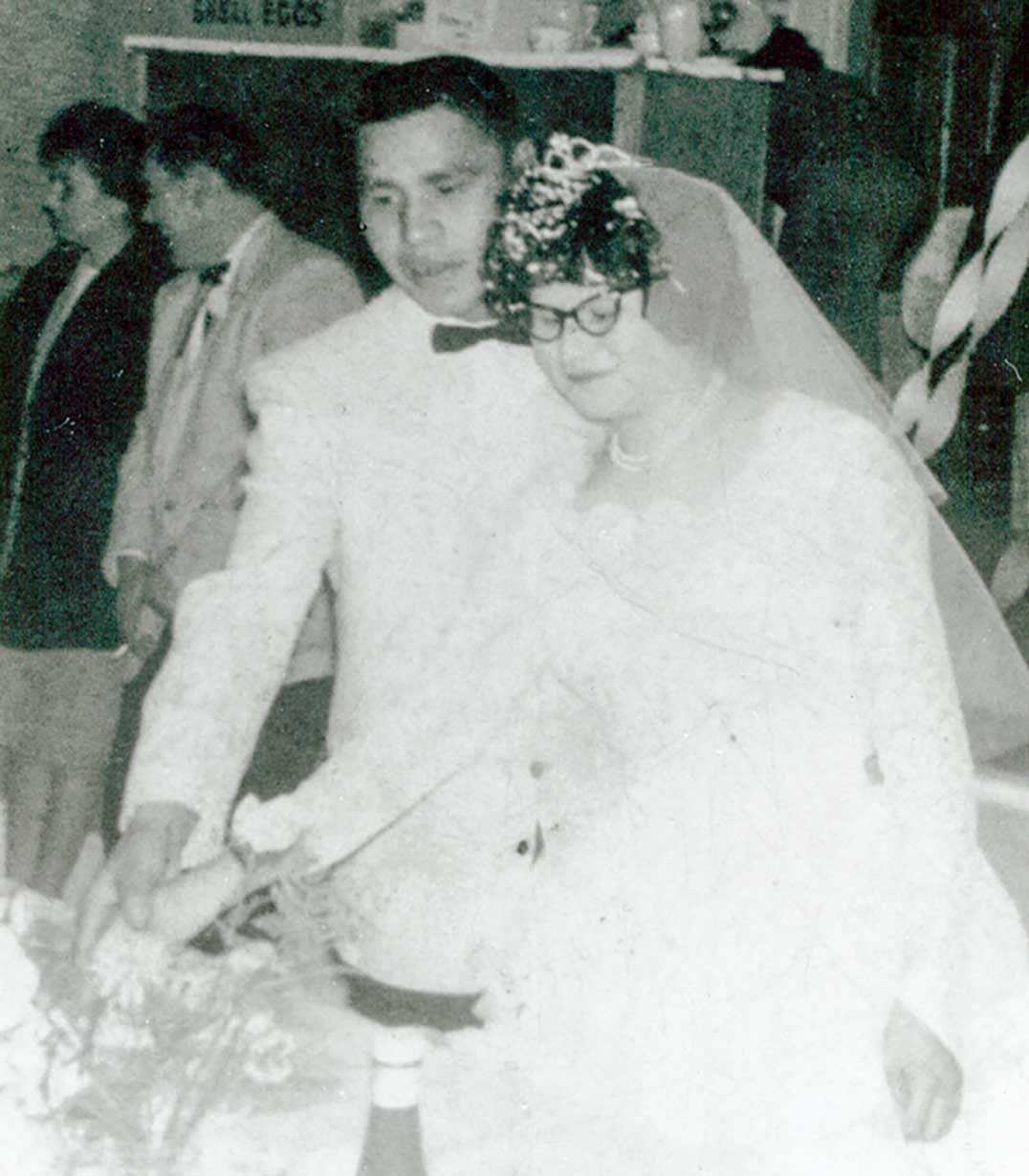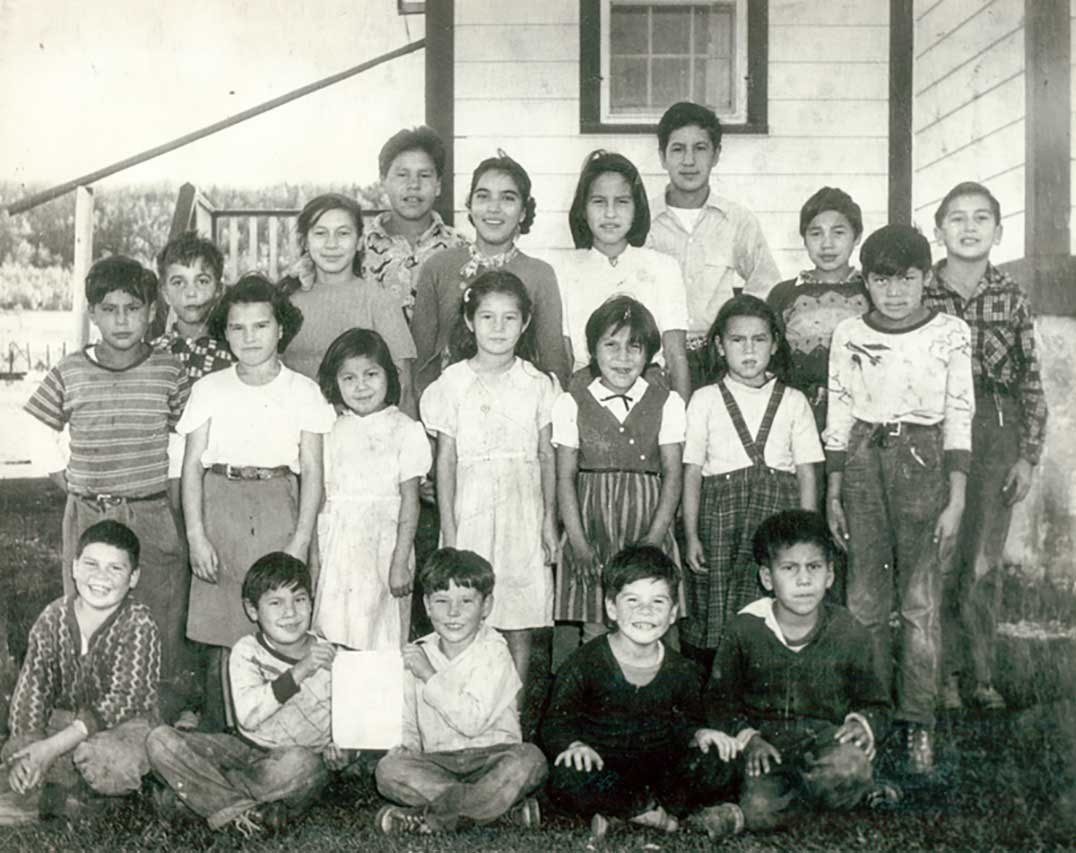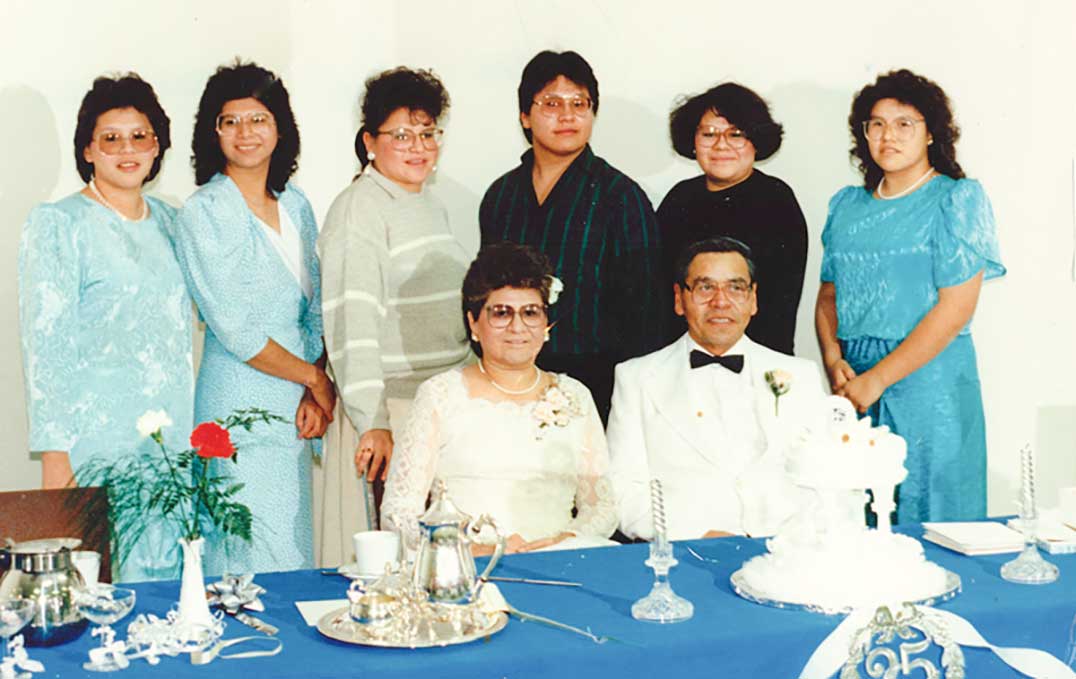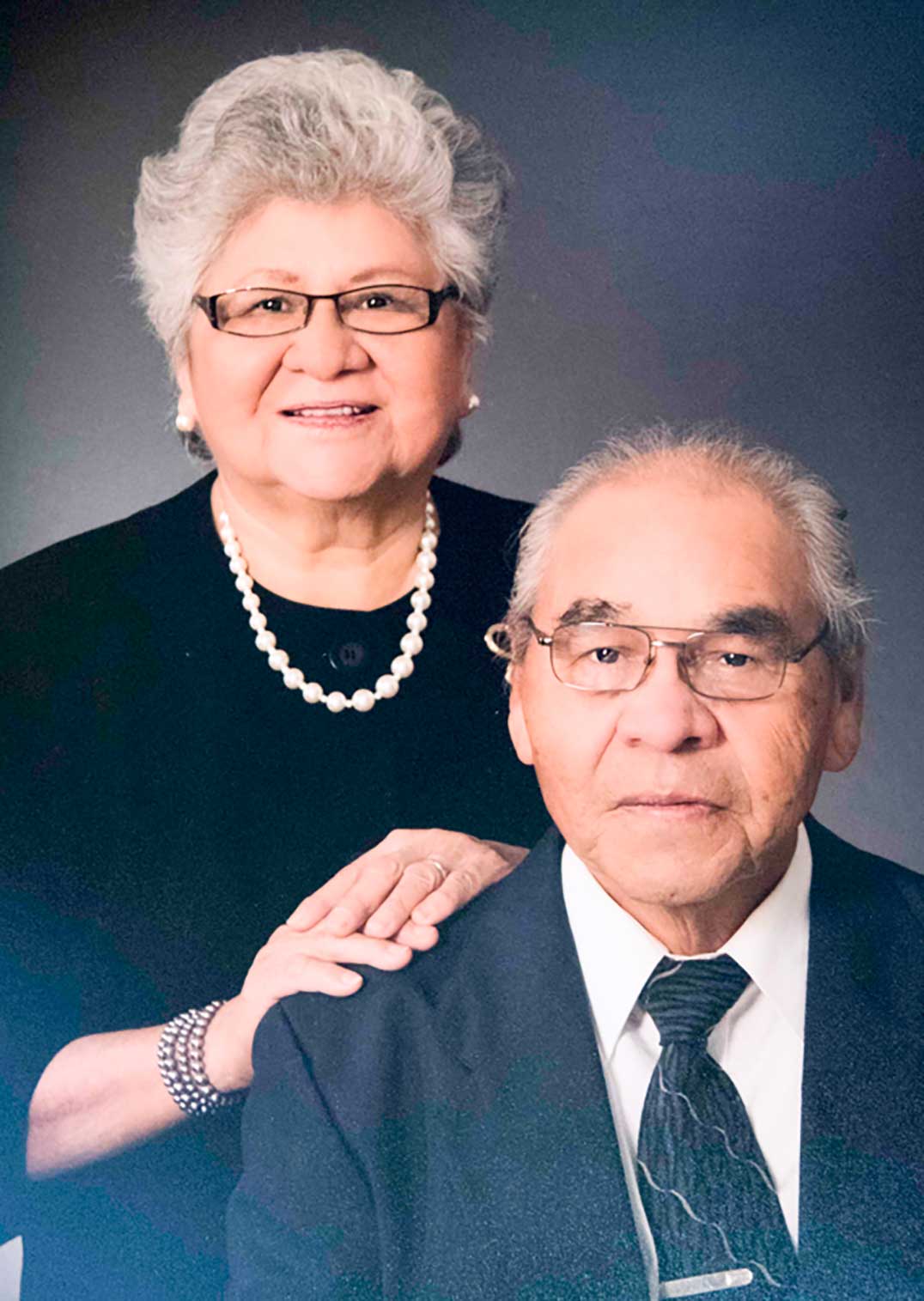by Petra Wall
Georgina Nahwegahbow
Georgina has always been proud of her culture, inspired initially by her ancestral roots, extending to her life up north as well as to her home on Manitoulin. “People on Manitoulin have their own culture. We have a unique way to get ready for the seasons and we share what we have, helping others when we can. We have gotten along with other cultures on the Island for over 100 years. Kids went to school together and grew up together. Schools have changed too. Native studies is a topic that is available in provincial schools now. That wasn’t the case 50 years ago.”
Georgina’s maternal grandmother died quite young. “She was getting water out of the lake in early fall when she died suddenly. We didn’t get to know her but I remember my grandfather quite well. He worked hard for his family,” she shares. “My paternal grandmother had a big garden which nourished her family. She worked even when she had a broken arm. The splint allowed her to continue her duties. The woodstove was always on and produced a continuous array of delicious cakes, stews, scones, bread or soups.”
Georgina was born on April 11, 1944 to Ignatius and Helen Stoneypoint at Sagamok First Nation. Helen’s maiden name was Shannonian, which means ‘south wind.’ Georgina’s grandmother was the midwife for the area and attended her birth. “There were 11 in my family, five girls and six boys. There were eight in Charlie’s. His family transferred to Sucker Creek from Birch Island in the 1940s. His father David and mother Sarah were hard-working people too. Dave farmed in the summer and lumbered in the winter. He also worked for the local township.”
“In those ‘walking days’ we went everywhere by foot. I remember my grandmother harnessing up the family dog to get groceries in Massey. Sometimes she would agree to buy some candy treats, doling them out very slowly to all her grandchildren. All necessities were provided by family and extended family. We all had clothes and food and anything else we needed.”

“I watched grandmother pick and make ‘m’shkiki’ or medicines for us. She would hang the berries and leaves on strings to dry. I tried to listen and watch carefully so I could provide these remedies to my own family later.” Sweet grass was dried too for handicrafts that could be sold to tourists. The local Americans who owned the lodges in the area would come regularly and buy crafts.
“One of my first memories was walking with my mother. I remember looking up at her as we walked to the home of an elder, a neighbour who was very sick. There was a small child, his grandson, laying in a hammock, in a tent, outside. We found the elder lying in his bed. The egg cup beside him, at my eye-level, was imprinted on my four-year old brain. It was likely left over from his breakfast that morning. I realized being old and sick still meant you had to eat.” For Georgina, the egg cup may have also signalled a sense of normal routine in a stressful situation, even though she was too young to comprehend the finality of physical death.
“My mother made dresses from flour bags and the sisters would argue about who got the next dress. Each bag was a little different and that made it more fun. My mother would make slips out of the white flour bags. We all wore slips under our dresses.”

The family lived in their log home year-round but would take the tent to go berry-picking or fishing on the shore. “I was the second born and I remember there were four or five of us originally heading out to harvest berries. We gathered blueberries, blackberries, gooseberries, and at homemade chow-chow (green tomato) that could be cured and stored. The whole family would pick for the entire day, often selling some of their yield to waiting buyers at the edge of the bush. We got $10 for an 11-quart basket and we would pick eight to 12 each day.”
“Some of the money would purchase sardines and corned beef for lunch the next day. Blueberries and bannock made a wonderful treat after lunch. The bannock would be cut into narrow strips and rolled in overlapping circles onto a stick. It would be cooked over the fire, slipped from the stick and the cavity filled with fresh blueberries or blueberry preserves. A flat leaf or birch bark made a good plate and sticks could be carved clean of branches and sharpened with a pocket knife. Dad always had a pocket knife.”

“Christmas and New Years were special. We would travel from home to home for five or six miles, on horse-pulled sleighs. This time of celebration was called ‘Namkoodaading.’ At each stop we would get an orange, an apple, mixed nuts or a candy from the hosts. Adults might also get a beer or some home brew. All food was shared. Occasionally, adults enjoying the home brew might wish to stay longer.”
“While adults were visiting, we were sleighing and sliding on deer hides or cardboard, with the other children. Occasionally the older boys had made a sled out of boards. It was normal to see a lot of deer hair from the hides on the most popular hills. At the end of the day, I was often tired and getting bored, waiting for the adults. I often vowed to stay home in the future, but I always changed my mind a year later.”
Georgina went up to Grade 8 in the Sagamok Reserve school, run by nuns. “When school started, we often got new shoes or boots from the store.” The one-room school was heated with a central stove, stoked with coal. The town would deliver the coal to the big bin. The teacher and the kids would bring the coal into the school. “I loved school, learning English and doing art. Initially it was a whole new culture for me: the nuns, Catholic religion and English; but once I got used to it, I was fine. We had one teacher that was mean. She was strap-happy. I remember getting the black strap for talking to my neighbour. I really tried to be good so I wouldn’t get hit. Eventually the parents had a meeting to see if this teacher could be sent away.”

High School was at the Residential Catholic School in Spanish. (Protestant and Anglican kids went to Sault St. Marie to the Shingwaak School.) “The Residential school was another cultural shock. We were introduced to the teachers and then everything after that was done by the bell. We got up at first bell at 6:30 am for mass, breakfast at second bell, and school at 9 am. Classes ended at 4 pm and homework was done from 7 to 9 pm and the last bell came at 9:30 pm for bedtime. They were trying to achieve ‘perfect coordination’ of all student activities. My mother had a good experience at Residential School and she wanted the same, ‘all the goods’ as she put it, for me.”
“Mrs. Gattie was a nice teacher and she could be convinced to let us watch television, if we finished our work early. The television set would be rolled in and we could watch a beloved variety show. None of us had this opportunity at home. At the end of the year, you had to pass all your subjects. If you failed one, you failed them all.”
Men looked after the furnace and the garden. Students were not allowed in the garden. Meals consisted of porridge, usually cream of wheat, and toast for breakfast. Vegetables like carrots and potatoes from the garden, were served for lunch and supper. “Sometimes we got Click (tinned) meat as a treat. One day I got a stalk of rhubarb after class and I snuck into the dining room to get some sugar or salt, either of which greatly enhanced the flavour of the rhubarb.”
“Cultural change was stressful at first, but we were able to visit our families for holidays, and enjoy the ambience at home. Some of the younger kids age six and under, kids who came from troubled homes or lived more than 10 miles away, didn’t have the same opportunity to see their families. There were no buses at the time. Girls who misbehaved were told to stand in the corner or they got the strap if the incident was more serious. That was the extent of abuse for the girls. Boys may have had a harder time at Residential School. The boys’ school closed in 1958.”

“Six of us, all from Sagamok, ran away from the school, once. Our parents had come to pick us up for the Hallowe’en Dance, a big event and dance back home. The sisters felt that a celebration featuring masks and costumes was not appropriate, so they did not allow us to leave. We thought this most unfair. Our Sagamok group scraped together all the money we had, adding up to about $15. We climbed out of our windows with the help of an emptied garbage can, and ran across the field to find a taxi. He charged us eight dollars to go home.”
“We all arrived to the dance. I was waiting outside when I saw my dad approach. He was angry that we had been disobedient and sent me home. The nuns had deduced that we all came from Sagamok and called the only family that had a phone, a crank-phone, ours! My dad took us back and then we got in trouble with the nuns. They claimed we had made a mess with the garbage can. They told us to go upstairs, have a bath and change our clothes.”
“After finishing Grade 10, I left the Residential School in 1961. I was told I would finish high school in a non-Native high school. I chose Sault Ste. Marie along with four other girls. My sister decided not to continue her education. This move was another cultural awakening for me. I boarded with a non-Native family. They ate different foods, lots of meat and even had frozen food. All their meals were prepared differently too. I was happy that I had my own room. I had household chores to do, like cleaning, vacuuming and laundry. I found out that lots of machines did the work now.”
“I finished Grade 11 and 12 with some help from my friends. One time, I had to write a book report in English and did not know how to do that. Other Anishinaabe girls explained the process to me and I did a good job after that. After I graduated, I got work in the Little Current Hospital and spent some time in Sucker Creek as part of a student employment program. That’s how I met Charlie Nahwegahbow. He was part of a circle of friends I was getting to know. Somehow, I just knew it was God’s plan that we would meet now and get together in the future.”
The couple married on a cold, snowy February 2, 1963 in the old Anglican Church in Sucker Creek. “We forgot all about Ground Hog Day,” Georgina adds, smiling. “We didn’t have time or money for a honeymoon.” The couple moved into an older home in Sucker Creek. There was no electricity, no indoor toilet and no running water. We had a wood stove. The carpenter’s mark of 1952, was left in the attic. Later this home was replaced with one of the first DIAND (Department of Indian Affairs and Northern Development) houses built in the community. It is the house on the corner of this street, right on Hwy 540. We moved into this new house just up the street, 12 years ago. The lot was bequeathed to Charlie by his dad. He had left one lot for each of his sons.”
“After the birth of our first baby, there were diapers to wash. We hauled water from the creek, heated the water on the wood stove and did our washing. Then we hung them out in the cold where they became frozen boards. Our family included six children in all, Glenda who has died, Andrea, Sarah, Alfie, Maureen and Paula. We have 12 grandchildren and 13 great-grandchildren. All the children and their offspring live here, in Aundeck Omni Kaning.”
“Our family fostered children from the Children’s Aid Society as well. We took in children who needed short-term care, but some stayed long enough to adopt us as their parents. We remain in close contact, helped by Facebook, and we still enjoy hearing ‘mom’ and ‘dad’ from them. Jamie and Linda, you are loved and always will be.”
“I really enjoyed watching the kids grow up and now our grandchildren. There was always lots of sharing since they were close together in age.” After the children were grown, Georgina decided to get a paying job in Little Current. “I became a cleaning lady, helping people take care of their homes. I also got work with our band in Lands and Estates Administration and did some counselling.”
Furthering her education, Georgina attended Laurentian University to take Native Studies, psychology and sociology. The young mother wanted to do some teaching herself. Teacher training came next at North Bay’s Nipissing University where she got her diploma. She joined the Teacher’s Federation of Ontario. “I decided to go north to isolated First Nations, like Pikangikum where you had to fly in. Charlie and I stayed six years. He would work at home in the summer and join me for the winter. We spent another 10 years in other communities: Sandy Lake, Wannimum Lake, Webeque, Fort Albany and Parry Sound.”
“Life was different there, another cultural awakening. People were tied to the land more closely in the north. They hunted and fished for their food. I learned the Odji-Cree language, similar to our own. I like to think that I was able to teach them new information as well and leave them a bit of our southern ways.”
“While I was training to be a teacher, I met and was inspired by Violet Shawanda, a teacher from Wiky. She later taught in Sagamok too,” Georgina adds. “Looking back, the most important event in my life was marrying a Christian man. Christianity has played a big role in our lives. Jesus is my lord and saviour. I knew that God had his plan for me and I hope I fulfilled it well by marrying Charles, sharing our spiritual, mental and physical love, being together for 50 years, and teaching northern isolated communities for 16 years of my life.”
“My favourite season is the fall. It shows us so much beauty. We know the growing season is over but there is still a lot of nature to enjoy. Fewer bugs and snakes are present too. It is time to get the flower beds and the garden ready for winter. Television shows? We don’t watch much television, a few talk shows and the news seem to be our main interests.” Georgina loves to work with her hands to create art. She has some splendid framed work displayed on her walls. She also loves to quilt, knit and crochet. In the spring, gardening is her main priority.
“What are my strengths? I like to think I am a good listener. Early in my life, my dad noticed two crowns (twirls of hair) on my scalp. He said, ‘You will be a traveller.’ He was right. I worked in the north, travelled also to Europe, North and South America, Alaska and Mexico. I would still like to see the Galapagos Islands and see England again. We visited England once but didn’t see all we wanted to see. We were also disappointed with the memorial for Princess Di. To us, it was just a dry, concrete circle, not worthy of her stature in life.”
“My best friend in school died a few years ago. We had been to elementary school together. She dropped out in Grade 8 but we stayed in touch and stayed friends all these years. There is nothing I would change if I could go back in time. My life is part of God’s plan. I will be happy if my children and grandchildren will think that I was a good mother and grandmother and the people in the community say of me, ‘she had a positive outlook on life’.”
Manitoulin, Mnidoo Mnising, God’s island, is one of the best places in the world. I am happy to live here. We are sheltered from storms that may rage around us. Life is a little slower here and real storms, higher winds and tornados are rare. I don’t remember any before the 1970s. We have a unique Manitoulin culture here too, one that displays lots of friendliness and wisdom. I never want to live elsewhere. My heart is here with my family and the people of this Island.”



